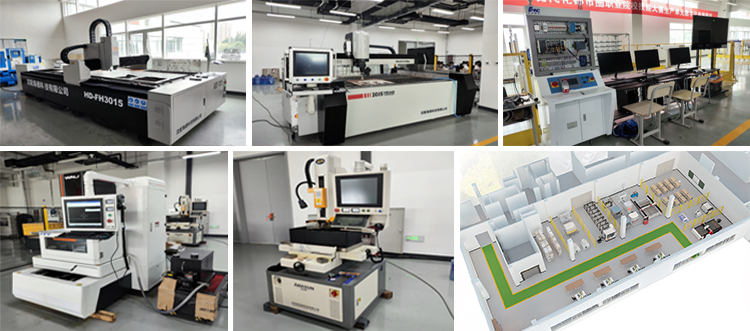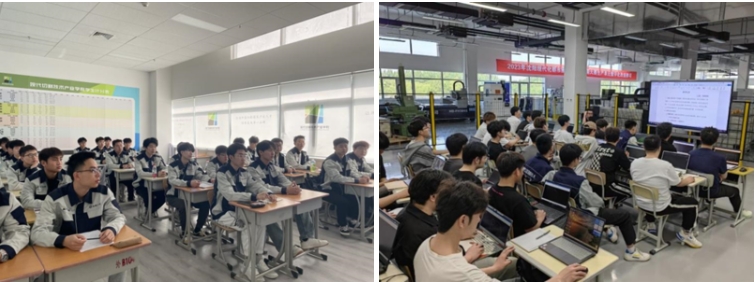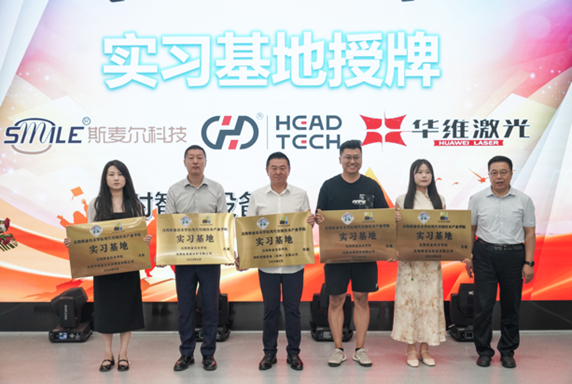I. Training Base Development The academy and the enterprise jointly invested in the establishment of a training base spanning over 800 square meters. Equipped with state-of-the-art cutting technology, including waterjet cutting, wire cutting, and laser cutting equipment, the facility offers students a comprehensive space for hands-on practice.The construction of the training base prioritizes intelligent and modernized equipment, integrating industry-leading technologies to ensure students gain exposure to the latest tools and operational skills. The curriculum is closely aligned with real-world industry demands, ensuring a seamless connection between what students learn and the standards and practices required in the workplace.Through an integrated teaching model that combines theory and practice, students not only acquire theoretical knowledge in the classroom but also apply it directly in the training lab. This "learn-and-do" approach enhances students' practical skills and operational proficiency, preparing them effectively for careers in cutting technology.

II. Dual-Education Teaching Model
The Industry Academy adopts a dual-education teaching model, combining the expertise of both academic faculty and enterprise professionals to cultivate well-rounded students. The academic faculty consists of qualified college educators with years of teaching experience and a solid theoretical foundation. They lead curriculum innovation and engage in scientific research to ensure high-quality course delivery.The enterprise teaching team is composed of cutting industry leaders, including experienced managers from top companies. With their extensive practical expertise and in-depth technical knowledge, they oversee course instruction, hands-on training, and internship guidance.This dual-education model ensures the curriculum remains cutting-edge and highly practical, preparing students to meet the demands of the industry with both theoretical knowledge and practical skills.

In addition, the college has set up a special “Expert Lecture Hall”, which regularly invites professors and industry experts from Shandong University, University of Science and Technology of China, Northeastern University, Shenyang University of Technology, Shenyang University of Aeronautics and Astronautics and other top universities. The experts not only have profound academic backgrounds and rich research results in their respective fields, but also have extensive influence in the industry. For example, professors from Shandong University focus on advanced manufacturing technology and have a number of national research projects; experts from the University of Science and Technology of China have made breakthroughs in the field of automation control systems; and professors from Northeastern University have extensive experience in the practical application of cutting technology. Through the lectures of these experts, students were able to learn about cutting-edge scientific and technological achievements and practical cases, which provided them with valuable guidance for their future career development.

III. Specialized Management System
The Industry Academy employs a small-class teaching model to ensure that every student receives personalized attention and guidance. Drawing on enterprise management practices, the academy instills a sense of responsibility and self-management in students. A unique incentive system is in place, including group competitions (PK) and a scholarship program, designed to motivate students to excel. At the end of each semester, students are assessed across multiple dimensions, such as classroom performance, learning logs, practical training, and final projects. Assessment results determine individual and team scores, rankings, and influence scholarship eligibility and priority in job placement opportunities. This system significantly boosts students’ learning enthusiasm and teamwork skills, addressing the common lack of motivation among traditional vocational students.
Additionally, the academy appoints full-time class advisors who supervise students’ academic and personal development. These advisors act as mentors and friends, offering career planning advice and psychological support through one-on-one meetings. To further prepare students for the workplace, the academy requires them to submit daily learning logs, fostering habits of reflection and adaptability to corporate work rhythms. These measures enhance students' learning outcomes and employability, enabling them to transition smoothly into their careers.
IV. Industry Alliance
The Modern Cutting Technology Industry Academy has established strong partnerships with over 30 leading enterprises in the cutting industry, forming the Modern Cutting Technology Industry Alliance. These companies, recognized as national high-tech enterprises, are thriving and place a high value on talent development.
Through this collaboration, the academy provides students with abundant internship and employment opportunities. The industry alliance facilitates a two-way selection process, ensuring an optimal match between students and enterprises, and fostering seamless integration of talent into the workforce.

The Academy regularly organizes visits to industrial alliance enterprises to help students understand the working environment and advanced equipment of the enterprises. These visits not only broaden students' horizons, but also motivate them to study at school, while helping them to determine their career direction and preferred enterprises. Enterprises have also been able to reduce training costs and accurately train professionals to meet their needs through cooperation with the college, improving overall employee stability and work efficiency.












